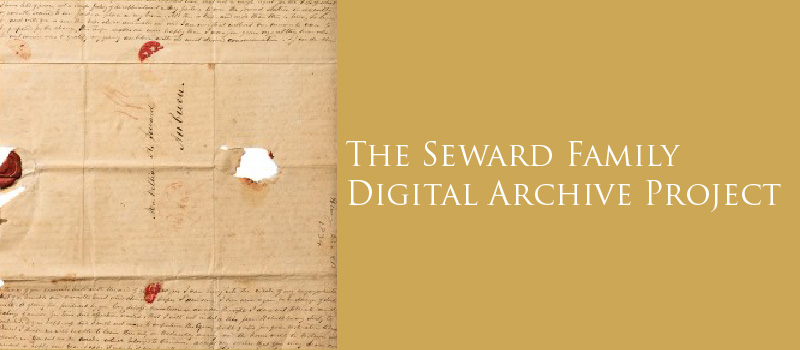About the feature photo: Letter from William Henry Seward to his wife, Frances Seward; December 29, 1834. // Wax seals and the holes left by them are pictured on letters comprising some of the University of Rochester’s Seward Papers collection, photographed in the Digital Humanities Center in Rush Rhees Library February 10, 2016 // photo by J. Adam Fenster / University of Rochester
Different Generations Bring Equally Valuable Yet Different Skills To “The Seward Family Digital Archive Project”
The William Henry Seward Papers are an extensive collection of handwritten documents that were found in boxes in the attic of the Seward Family home in Auburn, NY. This collection of 375,000 pages includes both personal and professional notes composed from the late 1700’s into the 1800’s.
These notes were given to the University of Rochester in the 1950’s. “Rochester vied with Yale and the Library of Congress for the papers; ultimately, Seward’s grandson chose Rochester as their home…”
The cursive handwriting style in which the notes are written is too foreign for many of today’s college students to decipher, so “… an intergenerational team of ‘citizen archivists’—led by Thomas Slaughter, the Arthur R. Miller Professor of History, and with the wide-ranging support of librarians at the River Campus Libraries—is working to bring to light the extensive holding of family papers in the collection.”
Slaughter’s team consists of undergraduate and graduate students, as well as a group of Highlands at Pittsford residents who are volunteering their time and expertise to the project. Our residents are bringing knowledge “that is not readily found in people in their late teens and 20s: an intimate familiarity with both letter writing and reading cursive handwriting”.
———–
In addition to the quotes above, the following are excerpts from a feature about this project on the University of Rochester website entitled “Lives in Letters”:
– The William Henry Seward Papers is one of the largest manuscript collections that the library holds and among the most often cited. Seward, who lived from 1801 to 1872, was a trial attorney, a New York state senator (1831–1838), governor of New York (1838–1842), U.S. senator (1849–1860), and secretary of state (1860–1869). He was the frontrunner for the Republican nomination for president in 1860, only to be sidelined in favor of someone more moderate in his support of abolition: Abraham Lincoln. Today he is best remembered for his decision to purchase Alaska—at the time, called “Seward’s Folly.” He was also attacked in the assassination plot that killed Lincoln. The collection of Seward’s papers, both professional and personal, includes 230 linear feet of materials, 150,000 items, and 375,000 pages.
![First year University of Rochester history PhD student Lauren Davis [bluish shirt] works with sophomore history and political science major Sarabeth Aranbold [grey sweater] and residents Lynn Nelson [red] and Allan Anderson [plaid] to transcribe letters for the Seward Family Papers Project at the Highlands in Pittsford, NY January 28, 2016. // photo by J. Adam Fenster / University of Rochester](https://www.highlandsatpittsford.org/wp-content/uploads/2016/04/seward3-300x201.jpg)
– As a little girl, volunteer Lyn Nelson remembers, she’d go to the library in the summertime and fill her bag with biographies. Now she finds a direct connection to history in the Sewards’ correspondence.
– She transcribed a letter in which Seward describes seeing the Washington Monument, already standing 15 feet above the ground.
– “I adore that!” says Nelson. “It just tickled me. It gave me shivers all over.”
– She says that “the whole project gives me energy, delight, interest. I find it—how should I phrase this? I’m eager to get to it, and eager to learn from it, and it adds something, a new dimension, to my life.”

